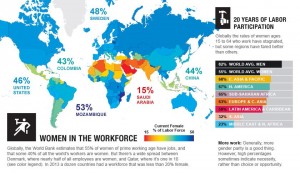Why aren’t there more women in the workforce?
< < Go Back
by Nina Easton,
An exclusive look at gender equality’s great stagnation from the Clinton Foundation.
If you’re a woman living in Uganda, Namibia, Ghana, or Nigeria (Africa’s largest economy), you are three times more likely than your husband, son, or brother to run a business.
But if you live in North Africa or the Middle East, forget it: The men in your life are three times more likely to own businesses.
Those are some of the fits and starts on women’s economic progress revealed in our exclusive look at a new report from Hillary and Chelsea Clinton’s No Ceilings: The Full Participation Project, the findings of which will be released on Monday. What’s especially striking is that women around the world are healthier and more educated, but no more likely to be collecting a paycheck than they were 20 years ago.
In fact, the percentage of women in the global workforce has stagnated at about 55%. And while labor participation rates for men actually dipped (to 82%)—and many women who work in the “informal” economy aren’t counted—the yawning male-female gap hasn’t been dented.
The No Ceilings report, produced in conjunction with the Gates Foundation and other groups, aggregates data from existing research to measure the progress of women globally since 1995, when the United Nations convened its much-heralded conference in Beijing on the status of women.
Nevertheless, “there are cultural norms that really challenge women,” notes No Ceilings director Terri McCullough. Take Asia: In China, 64% of adult women work in the growing economy. But in Japan—despite a longer history of modernity and high education rates—only 49% work, largely because of a social bias toward stay-at-home moms.
Interestingly, those same 2013 World Bank figures show the highest numbers of working women in African countries like Benin, Burkina Faso, Ethiopia, and Kenya. The lowest numbers in the world are in conservative Islamic strongholds like Iran, Iraq, Jordan, and Saudi Arabia.
With Hillary Clinton’s expected presidential run in the offing, the report is certain to feed some charged political debates: It points out that the U.S. is the only high-income country without mandated paid maternity leave—alongside such countries as Micronesia, Papua New Guinea, and Tonga. The continued wage gap between men and women is also highlighted, though conservative critics charge that these numbers are misleading—failing to take into account hours worked, interrupted years from childbearing, and choices in occupation. One thing about women’s progress (or lack thereof) that’s guaranteed? We’ll be hearing a lot more about it before next November.
More From Fortune Magazine:




